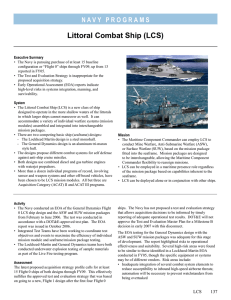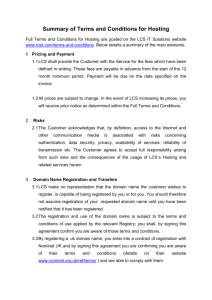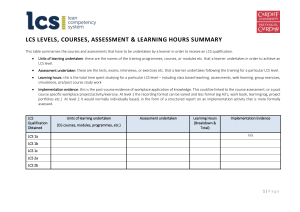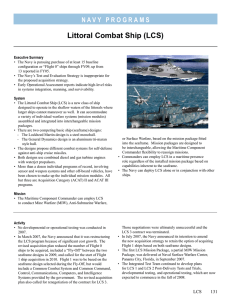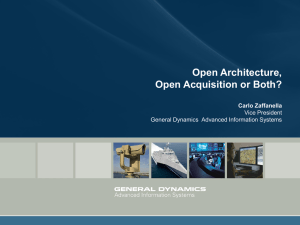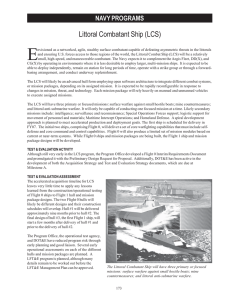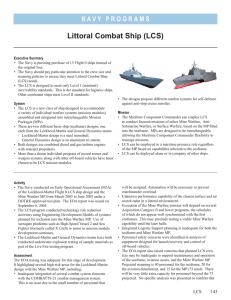Littoral Combat Ship (LCS)
advertisement
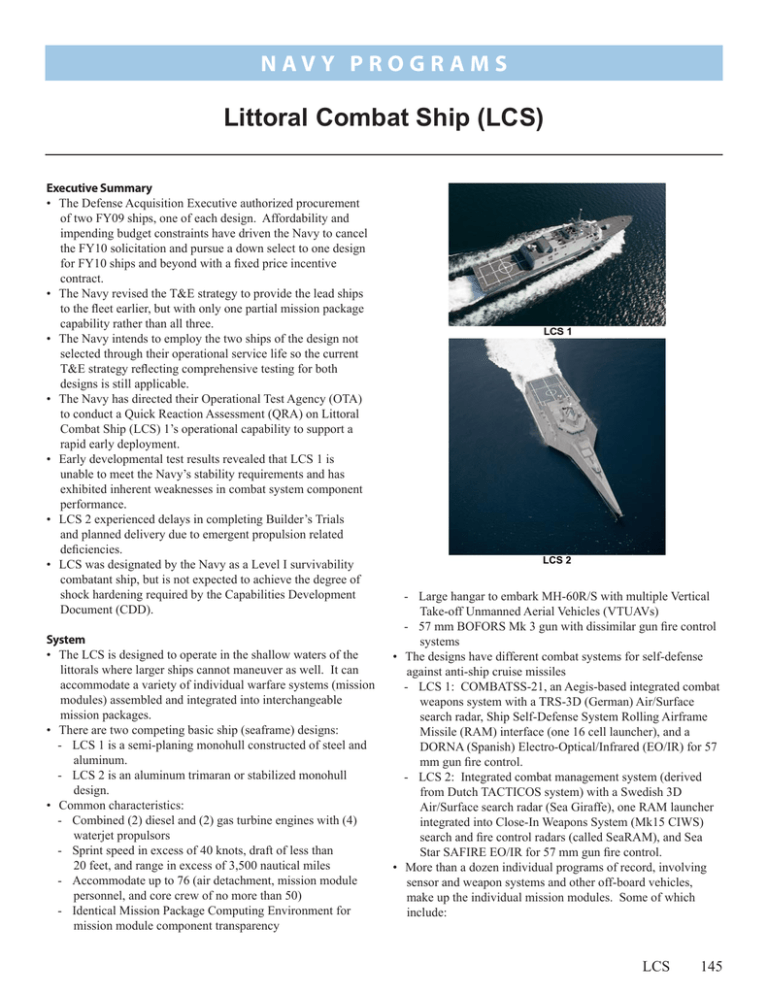
N a v y P ROGRA M S Littoral Combat Ship (LCS) Executive Summary • The Defense Acquisition Executive authorized procurement of two FY09 ships, one of each design. Affordability and impending budget constraints have driven the Navy to cancel the FY10 solicitation and pursue a down select to one design for FY10 ships and beyond with a fixed price incentive contract. • The Navy revised the T&E strategy to provide the lead ships to the fleet earlier, but with only one partial mission package capability rather than all three. • The Navy intends to employ the two ships of the design not selected through their operational service life so the current T&E strategy reflecting comprehensive testing for both designs is still applicable. • The Navy has directed their Operational Test Agency (OTA) to conduct a Quick Reaction Assessment (QRA) on Littoral Combat Ship (LCS) 1’s operational capability to support a rapid early deployment. • Early developmental test results revealed that LCS 1 is unable to meet the Navy’s stability requirements and has exhibited inherent weaknesses in combat system component performance. • LCS 2 experienced delays in completing Builder’s Trials and planned delivery due to emergent propulsion related deficiencies. • LCS was designated by the Navy as a Level I survivability combatant ship, but is not expected to achieve the degree of shock hardening required by the Capabilities Development Document (CDD). System • The LCS is designed to operate in the shallow waters of the littorals where larger ships cannot maneuver as well. It can accommodate a variety of individual warfare systems (mission modules) assembled and integrated into interchangeable mission packages. • There are two competing basic ship (seaframe) designs: - LCS 1 is a semi-planing monohull constructed of steel and aluminum. - LCS 2 is an aluminum trimaran or stabilized monohull design. • Common characteristics: - Combined (2) diesel and (2) gas turbine engines with (4) waterjet propulsors - Sprint speed in excess of 40 knots, draft of less than 20 feet, and range in excess of 3,500 nautical miles - Accommodate up to 76 (air detachment, mission module personnel, and core crew of no more than 50) - Identical Mission Package Computing Environment for mission module component transparency - Large hangar to embark MH-60R/S with multiple Vertical Take-off Unmanned Aerial Vehicles (VTUAVs) - 57 mm BOFORS Mk 3 gun with dissimilar gun fire control systems • The designs have different combat systems for self-defense against anti-ship cruise missiles - LCS 1: COMBATSS-21, an Aegis-based integrated combat weapons system with a TRS-3D (German) Air/Surface search radar, Ship Self-Defense System Rolling Airframe Missile (RAM) interface (one 16 cell launcher), and a DORNA (Spanish) Electro-Optical/Infrared (EO/IR) for 57 mm gun fire control. - LCS 2: Integrated combat management system (derived from Dutch TACTICOS system) with a Swedish 3D Air/Surface search radar (Sea Giraffe), one RAM launcher integrated into Close-In Weapons System (Mk15 CIWS) search and fire control radars (called SeaRAM), and Sea Star SAFIRE EO/IR for 57 mm gun fire control. • More than a dozen individual programs of record, involving sensor and weapon systems and other off-board vehicles, make up the individual mission modules. Some of which include: LCS 145 N a v y P ROGRA M S - Remote Multi-Mission Vehicle, an unmanned semi‑submersible that tows a special sonar to detect mines - Organic Airborne Mine Countermeasures, a family of systems employed from an MH-60S designed to detect, localize, and neutralize all types of sea mines - Unmanned Surface Vehicles, used in both mine and anti‑submarine warfare applications - VTUAV, specifically the Fire Scout • The Navy plans to acquire a total of 55 LCS, the first four being a mix of the two competing designs and the remaining seaframes a single design. Mission • The Maritime Component Commander can employ LCS to conduct Mine Warfare, Anti-Submarine Warfare, or Surface Warfare (SUW), based on the mission package fitted into the seaframe. With the Maritime Security Module installed, the ship can conduct sustained Level 2 Visit Board Search and Activity • DOT&E approved the Test and Evaluation Master Plan (TEMP) in December 2008. • The Defense Acquisition Board held a Milestone A-Prime review on December 18, 2008, to proceed with procurement of two (one of each design) FY09 ships (LCS 3 and 4) and mission packages. • On June 11, 2009, the Navy revised the T&E strategy to provide the lead ships to the fleet sooner albeit with only one (vice three) partial mission package capability. • On September 22, 2009, the Navy unveiled a revised acquisition strategy to down select to one design for the FY10 ships and beyond. The Navy intends to employ the two ships of the unselected design through their operational life expectancy. • LCS 1: - The Navy commissioned LCS 1 on November 8, 2008. - The Navy’s Board of Inspection and Survey completed a second Acceptance Trial (AT-2) in May 2009 to examine aspects of the ship’s performance that could not be evaluated during the initial trial. - The ship conducted structural test firings of core weapon systems and basic air defense performance characterization events in June 2009. - In July 2009, the Navy directed their OTA to conduct a QRA on the operational capability of USS Freedom (LCS 1) for maritime security operations in support of a rapid early deployment. A deployment nearly two years early will delay developmental testing and the initial phase of IOT&E until after the ship returns. - In September 2009, developmental test events were conducted in surface warfare and air defense. The Navy installed the initial increment of the Surface Warfare (SUW Mission Package, including two 30 mm gun mission 146 LCS Seizure Maritime Interception Operations. Mission packages are designed to be interchangeable, allowing the Maritime Component Commander flexibility to reassign missions. • Commanders can employ LCS in a maritime presence role regardless of the installed mission package based on capabilities inherent to the seaframe. • The Navy can deploy LCS alone or in conjunction with other ships. Prime Contractors • LCS 1 Prime: Lockheed Martin Maritime Systems and Sensors, Washington, District of Columbia; Shipbuilder: Marinette Marine, Marinette, Wisconsin • LCS 2 Prime: General Dynamics Corporation Marine Systems, Bath Iron Works, Bath, Maine Shipbuilder: Austal USA, Mobile, Alabama modules and mission package application software, conducted structural test firings of both 30 mm guns, and completed several basic surface gunnery events. • LCS 2: - Builder’s Trials commenced in July 2009. Main propulsion engine material problems have delayed completion until October 2009. - Acceptance trials are scheduled for late November 2009. - Delivery is now scheduled for December 18, 2009. • In July and August 2009, the Navy conducted end-to-end developmental testing of selected Mine Countermeasures (MCM) Mission Package components, including the Remote Multi-Mission Vehicle with the AN/AQS-20A towed sonar and the Unmanned Surface Vessel with the Unmanned Surface Sweep System using a containerized Mission Package Portable Control System embarked in Research Vessel Athena. • Funding constraints have delayed the Navy from completing the survivability assessments for LCS 1 and LCS 2 LFT&E until 2010. Assessment • The proposed changes to acquisition will not alter the test and evaluation strategy. Ships of the unselected design will be fleet operational units and will undergo the same testing as those of the winning design. • LCS 1: - Acceptance trial results assessed Deck and Weapons as unsatisfactory. Specific deficiencies include a non‑standard anchor chain configuration, and combat system (COMBATSS-21) performance problems associated with the WBR-2000 passive Electronic Support Measure system, the TRS-3D radar, and the DORNA EO/IR gun fire control system. N a v y P ROGRA M S - Analysis of the results of stability testing conducted in FY08 revealed that the ship will exceed limiting draft in the full load condition. This reduces the reserve buoyancy provided by compartments above the waterline and the ship’s capability to withstand damage and heavy weather. This condition also renders the ship incapable of meeting the Navy’s stability standard of withstanding flooding to 15 percent of the length along the waterline and could sink sooner than expected. The Navy intends to install external tanks to effectively lengthen the stern to increase buoyancy prior to early deployment and to modify the future hull design with a lengthened transom. - Early fielding of lead ships in test remains consistent with recent Navy practice; e.g., USS Virginia (SSN 774) and USS San Antonio (LPD-17). As stipulated in Section 231 of the National Defense Authorization Act of 2007, an Early Fielding Report will be submitted. - Although equipment performance issues delayed completion of the 30 mm gun structural test firings, results of those events and the core weapons structural test firings were satisfactory. - Early air target tracking tests identified combat system performance deficiencies that will seriously degrade the ship’s air defense capability unless corrected. Plans to repeat the tests with software upgrades were delayed by multiple TRS-3D radar power supply failures, the cause of which has not yet been identified. - Completion of basic air defense performance characterization events has been delayed due to repeated TRS-3D radar power supply failures. • LCS 2: - Builders trials were initially delayed due to reported leaks at the gas turbine shaft seals. More testing identified additional deficiencies related to the main propulsion diesel engines, thus further delaying completion of the trials until October 2009. • MCM mission package end-to-end test objectives were met, but communication problems associated with the unmanned remotely controlled vehicles indicates more development of component systems is needed prior to fleet integration. • LCS was designated by the Navy as a Level I survivability combatant ship, but neither design is expected to achieve the degree of shock hardening as required by the CDD. Shock hardening (ability to sustain a level of operations following an underwater explosive attack) is required for all mission critical systems, as required by a Level 1 survivability requirement. Only a few selected subsystems will be shock hardened, supporting only mobility to evacuate a threat area following a design-level shock event. Accordingly, the full, traditional rigor of Navy-mandated ship shock trials is not achievable, due to the damage that would be sustained by the ship and its many non-shock-hardened subsystems. • The LCS LFT&E program has been hampered by the Navy’s lack of credible modeling and simulation tools for assessing the vulnerabilities of ships constructed to primarily commercial standards (American Bureau of Shipping Naval Vessel Rules and High Speed Naval Craft Code), particularly aluminum and non-traditional hull forms. Legacy LFT&E models were not developed for these non-traditional factors, nor have they been accredited for such use. These knowledge gaps undermine the credibility of the modeling and simulation, and increase the amount of surrogate testing required for an adequate LFT&E program. • The LCS is not expected to be survivable in a hostile combat environment as evidenced by the limited shock hardened design and results of full scale testing of representative hull structures completed in December 2006. Recommendations • Status of Previous Recommendations. The Navy satisfactorily addressed all but three of the previous nine recommendations. Recommendations concerning a risk assessment on the adequacy of Level I survivability, detailed manning analyses to include mission package support, and solidifying the acquisition strategy for long-range planning still remain. • FY09 Recommendations. The Navy should: 1. Continue to address LCS deficiencies identified in Acceptance Trials and early developmental testing and incorporate appropriate modifications, especially in stability and the TRS-3D radar performance and integration with other combat system components. 2. Codify another revised T&E strategy in a TEMP revision that provides for completion of IOT&E in LCS 1 following early fielding deployment and supports completion of IOT&E in LCS 2 and subsequent ships prior to operational deployment. 3. Enlist the support of the T&E community to evaluate the performance of LCS 1 and the Navy’s shore support organization during the ship’s first operational deployment and compile appropriate lessons learned. 4. Assess the testable shock severity achievable during ship shock trials for both LCS variants in order to predict the degree of shock hardness and survivability expected of these ships in a combat shock environment. 5. Develop a robust LFT&E program to address knowledge gaps in assessing the vulnerabilities of ships constructed primarily to commercial standards including aluminum structures and non-traditional hull-forms, to include 57 mm gun system and Non-Line-of-Sight missile lethality. LCS 147 N a v y P ROGRA M S 148
